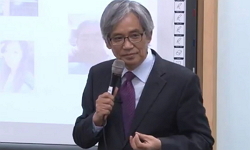이 논문의 목적은 그림과 관련된 비가시적 종교성에 대한 벤야민과 그람시의 의문을 논하는 것이다. 요점은 두 철학자가 지나간 이미지에 대한 이해에서 일시성의 새로운 개념을 도입하려...
http://chineseinput.net/에서 pinyin(병음)방식으로 중국어를 변환할 수 있습니다.
변환된 중국어를 복사하여 사용하시면 됩니다.
- 中文 을 입력하시려면 zhongwen을 입력하시고 space를누르시면됩니다.
- 北京 을 입력하시려면 beijing을 입력하시고 space를 누르시면 됩니다.

지금-여기의 시간과 비가시성의 종교성 - 벤야민과 그람시, 그리고 그림 - = Now-here’ (Nowhere) and the Invisible Religiosity - Benjamin, Gramsci and Their Concepts of Painting -
한글로보기부가정보
국문 초록 (Abstract)
이 논문의 목적은 그림과 관련된 비가시적 종교성에 대한 벤야민과 그람시의 의문을 논하는 것이다. 요점은 두 철학자가 지나간 이미지에 대한 이해에서 일시성의 새로운 개념을 도입하려고 시도한다는 것이다. 약한 메시아니즘에 대한 벤야민 의 개념은 종교 없는 종교적 형태에 대한 그의 관심을 보여준다. 그람시는 고대그림에 대한 분석에서 비가시성의 개념을 제시한다. 비가시적 종교는 여러 종교의 다양성, 비재현적 요소, 즉 잠재적인 종교적 관습에 의존하고 있다. 베냐민과 그람 시는 다양한 예술적 실험, 특히 그림에서 이러한 것들이 실현된다고 본다. 베냐민의 관점에서 그림은 이미지가 대안적인 역사에 대한 상상을 불러일으키는 또 다른 세계이다. 반면에 그람시는 그림에 있는 아가멤논의 가려진 얼굴을 표현할 수없는 고통과 슬픔으로 본다. 이러한 비가시적 재현이 시각적 의미의 핵심이거나 그림의 형식적 논리이다. 내 결론은 비가시적 종교성이 있어야 할 자리가 바로 메시아니즘이 없는(nowhereness) ‘지금 여기’(now-here)라는 것이다.
다국어 초록 (Multilingual Abstract)
The aim of this essay is to discuss Benjamin’s and Gramsci’s questions of the invisible religiosity concerning painting. My point is that both philosophers attempt to bring in the new concepts of temporality in their understanding of the past imag...
The aim of this essay is to discuss Benjamin’s and Gramsci’s questions of the invisible religiosity concerning painting. My point is that both philosophers attempt to bring in the new concepts of temporality in their understanding of the past images. Benjamin’s concept of the weak messianism is the evidence of his interests in the religious forms without religion. Gramsci also brings forth the concept of the invisibility in his analysis of an ancient painting. The invisible religiosity relies on the multiplicity of many religions, its non-representational aspects, in other words, the potentiality of religious practices. Benjamin and Gramsci seem to see these performative realizations in the various artistic experiments, in particular, paintings. In Benjamin’s sense, a painting is another world in which the images will bring in the imagination of the alternative history, while Gramsci sees the veiled face of Agamemnon in the painting as the impossible representation of agony and sadness. These invisible representations are the core of the visual meanings, or the formal logic of the paintings. My conclusion is that the very locus of the invisible religiosity is nothing less than the place of ‘now-here’, the nowhereness of messianism.
목차 (Table of Contents)
- Ⅰ. 들어가며 Ⅱ. 새로운 천사 Ⅲ. 유물론과 신학 Ⅳ. 메시아의 시간 Ⅴ. 베일의 효과 Ⅵ. 예술적 장치와 종교성
- Ⅰ. 들어가며 Ⅱ. 새로운 천사 Ⅲ. 유물론과 신학 Ⅳ. 메시아의 시간 Ⅴ. 베일의 효과 Ⅵ. 예술적 장치와 종교성
동일학술지(권/호) 다른 논문
-
Developments of the Interpretation of ‘within the Veil’(Heb. 6:19-20) within Adventism
- 삼육대학교 신학연구소
- 지상훈(Jee, Sang-hoon)
- 2020
- KCI등재후보
-
히브리서에 나타난 카타페타스마(καταπέτασμα)에 관한 연구
- 삼육대학교 신학연구소
- 장석원(Jang, Seokwon)
- 2020
- KCI등재후보
-
서평: 배철현. 『창세기, 샤갈이 그림으로 말하다』. 서울: 코바나컨텐츠. 2011.
- 삼육대학교 신학연구소
- 김용선
- 2020
- KCI등재후보
-
운보 김기창의 <예수의 생애> 작품을 통한 기독교 토착화 담론
- 삼육대학교 신학연구소
- 심영옥(Sim, Youngok)
- 2020
- KCI등재후보




 스콜라
스콜라






